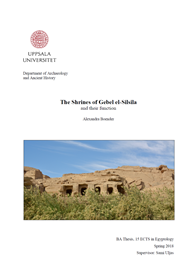| Main » Ad Board » ДРЕВЕН ЕГИПЕТ И АФРИКА » Архитектура |
| 23.06.2020, 12:53 | |
Разположените в скалистия пролом на Нил между Горен и Долен Египет архитектурни паметници на Джебел ел Силсила са издълбани в скалата през епохата на Новото царство. Дълго време са считани за кенотафи (фалшиви гробници), тъй като висшите чиновници за които те са изградени и чиито имена са изписани в тях, всъщност са погребани в Тиванския некропол. Основна теза на автора на настоящата дипломна работа е, че те са всъщност персонални светилища, построени в памет на починалите, но които не са имали практическа функция и в тях не са провеждани за заупокойни служби. Основната им роля е била да символизират отвъдния свят, представян като водите на Нил, които са ги потапяли по време на ежегодния разлив.
- на английски език, от DiVA (Digitala Vetenskapliga Arkivet), формат PDF.Свалянето става с десен бутон (downloading by right button) и Save as... АЛТЕРНАТИВЕН ЛИНК / ALTERNATIVE LINK:
- на английски език, от Google Drive,формат PDF. Сваляне с ляв бутон (downloading by left button) от страницата на предоставящия сървър, после през бутона стрелка надолу/after by down arrow button.
| |
| Views: 813 | Placed till: 23.07.2020 | Rating: 0.0/0 | |

